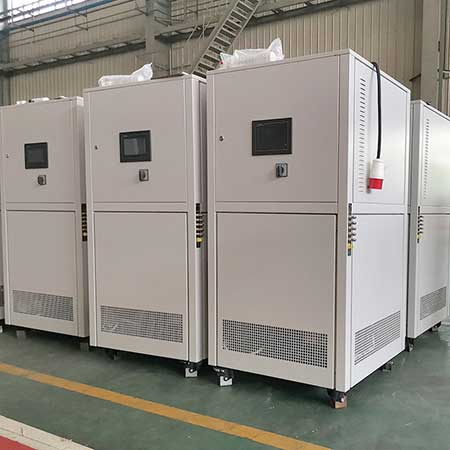Glycol Chilled Water System
Kontaktieren Sie uns noch heute für die perfekte Lösung zur Temperaturkontrolle
For low-temperature chillers using ethylene glycol solution, we call it glycol chilled water system. Its outlet water temperature is generally set below -10°C, and the specific temperature requirements are subject to user needs. Glycol chilled water systems are common in chemical plants. In order to ensure the safe and stable operation of the units, many chemical plants will strictly require explosion-proof measures for the chillers, which is what we often call explosion-proof chillers.
The structural components of low-temperature chillers are roughly the same, consisting of compressors, evaporators, condensers, throttling components, and electronic control systems. However, for glycol chilled water systems, they use low-temperature compressors and are equipped with economical separators. There are still some differences among other parts.

Working principle of glycol chilled water system
1. Compression
In order to keep the pressure in the evaporator low enough to ensure that the refrigerant is boiling at a low enough temperature, a compressor is used to pump away the evaporated refrigerant gas, that is, to compress the low-temperature and low-pressure refrigerant vapor into high-temperature and high-pressure gas. Refrigerant gas. When the suction speed of the compressor is greater than the evaporation speed of the refrigerant, the evaporation pressure will decrease and the evaporation temperature will also decrease; conversely, if the suction speed of the compressor is less than the refrigerant’s evaporation speed, the evaporation temperature and pressure will rise accordingly. High, when the compressor suction speed is equal to the refrigerant evaporation speed, equilibrium is established.
2. Condensation
The high-temperature and high-pressure refrigerant is condensed into liquid in the condenser. In the condenser, the refrigerant releases heat to air or water that is lower than its temperature. This part of the heat includes the heat absorbed by the refrigerant when it evaporates in the evaporator and the heat converted into it when the compressor compresses it.
Special attention: the temperature of the air or water must be lower than the temperature of the refrigerant, otherwise the refrigerant cannot release heat, that is, the temperature of the cooling medium is lower than the temperature of the refrigerant gas at the compressor outlet.
3. Throttling
Through the throttle, the pressure of the refrigerant is reduced from the condensing pressure to the evaporating pressure. The liquid coming out of the condenser is stored in the liquid receiver. At this time, the refrigerant is at normal temperature and high pressure. After passing through the expansion valve, the boiling point is lowered due to the pressure drop. After the liquid enters the evaporator, it easily absorbs heat and evaporates.
4. Evaporation
The low-temperature and low-pressure refrigerant liquid passing through the throttle exchanges with the secondary refrigerant in the evaporator, absorbs heat, and becomes saturated or superheated vapor to be compressed by the compressor.
E-Mail: info@lneya.com WeChat ID: +8615251628237 WhatsApp: +86 17851209193

Rückkühler / Umwälzkühler
Die Kältemaschine kann in verschiedenen Industrien und Labors eingesetzt werden und unterstützt kundenspezifische Designs.
| Temperaturbereich | Serie -25°C ~ +30°C | -45°C ~ +30°C Reihe | Serie -60°C ~ -20°C | Serie -80°C ~ -20°C | Serie -120°C ~ -70°C | ||||
| Kühlleistung | 0,8 ~ 30kW | 0,75 ~ 12kW | 0,4 ~ 6kW | 0,2 ~ 6kW | 0,3 ~ 5kW | ||||
| Hinweis: Jeder Temperaturbereich von -150℃ ~ +350℃ und jede Kühlleistung kann angepasst werden | |||||||||
 Kaltwassersätze / Kleinkaltwassersätze
Kaltwassersätze / Kleinkaltwassersätze
Die Kältemaschine kann in verschiedenen Industrien und Labors eingesetzt werden und unterstützt kundenspezifische Designs.
| Temperaturbereich | -18°C ~ +30°C | +5°C ~ +35°C Reihe | |||||||
| Kühlleistung | 0,35 ~ 0,9kW | 1,8 ~ 50kW | |||||||
| Hinweis: Jeder Temperaturbereich von -150℃ ~ +350℃ und jede Kühlleistung kann angepasst werden | |||||||||

Niedertemperatur-Kühlgeräte
Wir haben uns auf die Herstellung von Niedertemperaturkältemaschinen mit einem Temperaturregelbereich von bis zu -150°C spezialisiert, die den Kühlbedarf verschiedener Branchen decken.
| Temperaturbereich | Serie -25°C ~ -5°C | Serie -45°C ~ -10°C | Serie -60°C ~ -10°C | Serie -80°C ~ -30°C | Serie -110°C ~ -50°C | Serie -150°C ~ -110°C | |||
| Kühlleistung | 12 ~ 360kW | 6 ~ 180kW | 6 ~ 180kW | 4 ~ 180kW | 2 ~ 120kW | 2,5 ~ 11kW | |||
| Hinweis: Jeder Temperaturbereich von -150℃ ~ +350℃ und jede Kühlleistung kann angepasst werden | |||||||||
Kühlen und Heizen Kaltwassersätze

Kühlen und Heizen Kaltwassersätze
Temperaturregelbereich: -120°C bis +350°C
Anwendung: Verschiedene Reaktoren (Mikrokanäle, Glas, ummantelte Reaktoren usw.), Destillations- oder Extraktionssysteme, Labor, Universität, Forschungsinstitut, Luft- und Raumfahrt, Automobilindustrie, Halbleiter- und Elektrotests, Chemie, Pharmazie, Petrochemie, Biochemie, Medizin, Krankenhaus, F&E-Werkstatt, Luft- und Raumfahrt, Biologie und andere Industrien.
| Temperaturbereich | Serie -10 ~ +150°C | Serie -25 ~ +200°C | Serie -25 ~ +300°C | Serie -45 ~ +250°C | Serie -45 ~ +300°C | Serie -60 ~ +250°C | Serie -60 ~ +300°C | Serie -70 ~ +250°C | Serie -80 ~ +250°C | Serie -90 ~ +250°C | Serie -100 ~ +100°C | ||
| Kühlleistung | 1,5 ~ 15kW | 1 ~ 200kW | 1 ~ 200kW | 0,45 ~ 200kW | 0,9 ~ 25kW | 0,25 ~ 60kW | 0,75 ~ 25kW | 0,4 ~ 15kW | 0,3 ~ 80kW | 0,2 ~ 80kW | 0,45 ~ 80kW | ||
| Hinweis: Jeder Temperaturbereich von -150℃ ~ +350℃ und jede Kühlleistung kann angepasst werden | |||||||||||||

Kühlgeräte mit Rücklaufheizung
Temperaturregelbereich: -45°C bis +250°C
Anwendung: Verschiedene Reaktoren (Mikrokanäle, Glas, ummantelte Reaktoren usw.), Destillations- oder Extraktionssysteme, Labor, Universität, Forschungsinstitut, Luft- und Raumfahrt, Chemie, Pharmazie, Petrochemie, Biochemie, Medizin, Krankenhaus, F&E-Werkstatt, Luft- und Raumfahrt, Biologie und andere Industrien.
| Temperaturbereich | Serie -25°C ~ +200°C | Serie -45°C ~ +250°C | |||||||
| Kühlleistung | 1 ~ 15kW | 0,25 ~ 15kW | |||||||
| Hinweis: Jeder Temperaturbereich von -150℃ ~ +350℃ und jede Kühlleistung kann angepasst werden | |||||||||
 LNEYA
LNEYA
 简体中文
简体中文


















































































